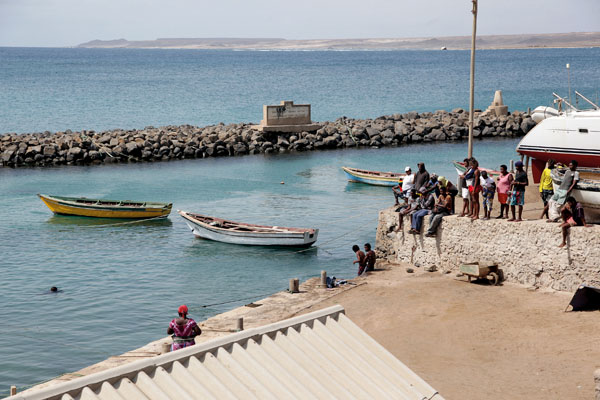
Cabo Verde is an archipelago consisting of ten islands and five islets of volcanic origin in the Atlantic Ocean off the coast of Senegal. The capital, Praia, is part of Santiago Island, which is the largest island and home to the biggest share of the country’s population.
Although most of the islands have a rugged terrain consisting of volcanic soil, others are flat and sandy with scant vegetation and a hot, dry climate. Annual rainfall is approximately 182 mm in Praia, and even less on other islands, with the result that surface and drilling water resources are very limited and vegetation is generally scarce. The islands of Santo Antão and São Nicolau are, to some extent, an exception on the north-eastern side, which is more exposed to the moisture from the ocean. Although the connection rate to the water network is very high in Cabo Verde, covering the needs of the population and contamination of the scarce resources are real challenges for the future.
These uninhabited islands were discovered and colonised in the 15th century by the Portuguese. Cabo Verde then became an important hub in the African slave trade and later a refuelling stop for whaling and trans-Atlantic navigation. After independence from Portugal in 1975 and an attempt at unification with Guinea-Bissau, a one-party system was established and maintained until multi-party elections took place in 1990. Cabo Verde can subsequently boast to having one of Africa’s most stable democratic governments.
In 2021, the resident population of Cabo Verde was approximately 491 233, with a net migration rate of -2,2 migrants / 1 000 population. The succession of droughts in the second half of the 20th century made life so difficult that a large part of the population preferred to emigrate. This outflow was further exacerbated by a new wave of droughts starting in 2017, a year in which there was almost no recorded rain in the country. Since 2014, the country registered a total net population decline of 8.7%. As a result, Cabo Verde’s expatriate population is still higher than the resident population in the country, with estimates now ranging up 700 000 Cabo Verdeans living abroad, primarily in the US and Europe. The resident population is young and around 28% is under 15 years of age.
In spite of heavy constraints and limited potential regarding natural resources, Cabo Verdeans made genuine progress in terms of economic growth. GDP per capita recorded one of the largest increases among countries in sub-Saharan Africa, rising from USD 842 in 1990 to USD 3 503 in 2008, but growth has remained flat since the economic crisis (USD 3 293 in 2021). A substantial part of the economic fabric is devoted to tourism, but this saw a significant reduction as a result of the global pandemic - from 38% of GDP in 2019 to 16% in 2020.
Cabo Verde’s growth has been possible thanks to an economic development strategy based on the private sector and the country’s integration into the global economy. However, this strategy has been strongly induced from abroad: the transfer of funds from Cape Verdean emigrants (16% of GDP), foreign aid and tourism revenue. Moreover, Cabo Verde’s trade balance is typically very uneven, with imports in 2022 around 15 times higher than the country’s total exports.
The good performance in terms of growth is also reflected through the Human Development Index which, in 2021, placed Cabo Verde in 127th position out of 192 countries. Moreover, Cabo Verde is no longer ranked in the group of least developed countries: in 2007 it joined the list of lower middle-income countries.
Cabo Verde is, however, still fragile: the economy is vulnerable and highly dependent on foreign aid, and poverty is on the rise. In 2007, 26.7% of the population was considered poor, with half living in extreme poverty. Current estimates are still being calculated, but the poverty rate has likely increased since 2007. The official unemployment rate is approximately 8,3%, and the poor populations are the most affected. In this context, the cooperation programmes between Cabo Verde and Luxembourg in support of vocational training and employment make complete sense, especially in the dynamic tourism sub-sector.
Cabo Verde has been a partner country of the Luxembourg Cooperation since the late 1980s, and a General Cooperation Agreement was signed as far back as 1993. The first Indicative Cooperation Programme (ICP) was concluded into in January 2002 to define the cooperation relationship between Cabo Verde and Luxembourg. The first interventions focused on water, secondary and technical education and health. Today, the programmes implemented by LuxDev in Cabo Verde concentrate on vocational training and employment as well as sectorial support for water and sanitation. In the framework of the new ICP V signed in 2021, Luxembourg has extended its support to the sectors of energy transition as well as climate governance and climate action in Cabo Verde.
Evolution of activities in Cabo Verde (in thousand EUR)
Distribution of the 2022 disbursements by sector
All projects in Cabo Verde
-
CVE/088Employment and employability sector support programme
-
CVE/092Sectoral budget support for employment and employability in Cabo Verde
-
CVE/093Sectoral budget support in the health sector in Cabo Verde
-
CVE/094Support to the Fourth National Household Income and Expenditure Survey in Cabo Verde
-
CVE/095Support for the production, analysis and dissemination of quality statistics in Cabo Verde
